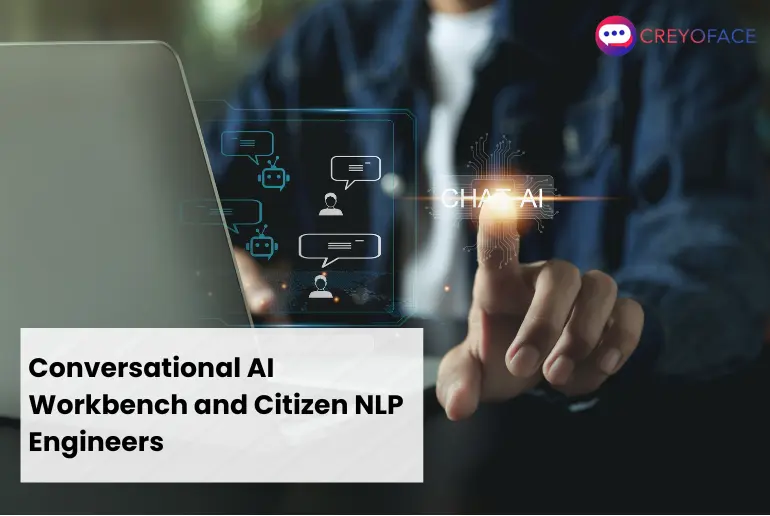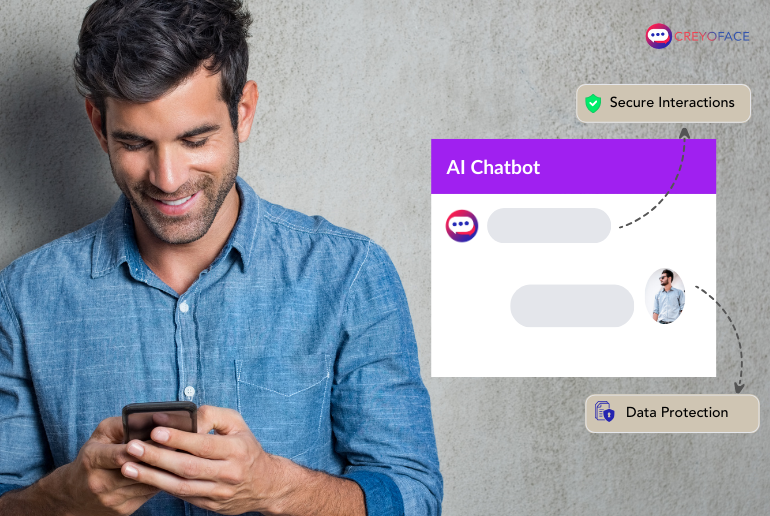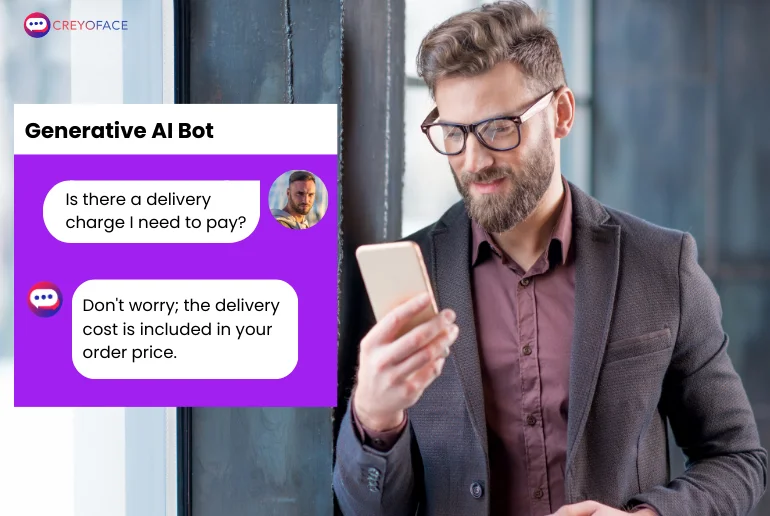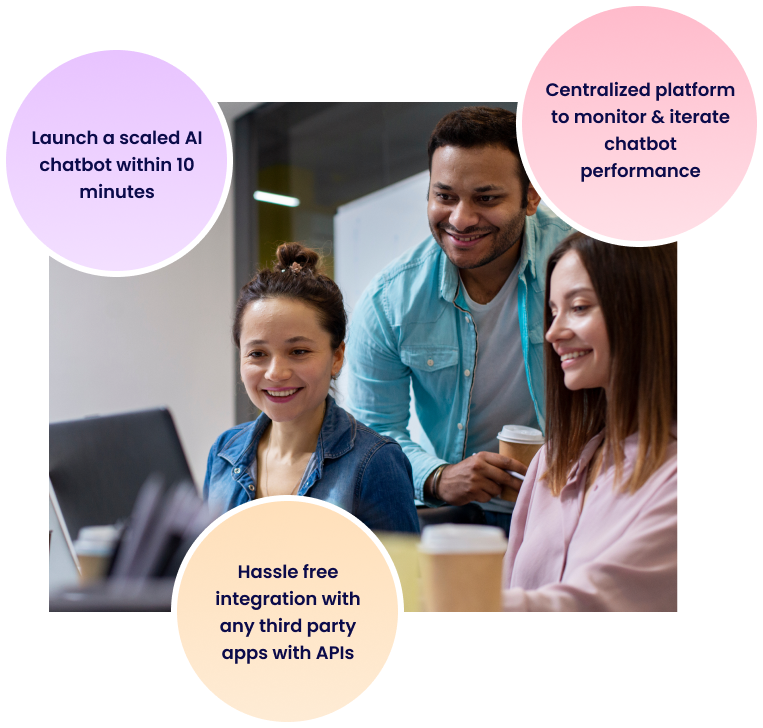Have you ever thought about creating an intelligent chatbot but don’t know where to start? That’s where the conversational AI workbench and the world of Citizen NLP Engineers come in!
These powerful tools make building AI-driven chatbots surprisingly easy—no need for deep tech skills – just your creativity and ideas.
Whether aiming to boost your business, enhance learning, or just play with cutting-edge tech, our journey through these user-friendly AI platforms will show you how. It’s an exciting time to be part of the AI revolution, and you’re just one step away!
Introduction
Chatbots have long been a staple in business communication, but imagine taking them to the next level. Today, we have simple, no-code tools that anyone can use to create a basic chatbot. But soon, these tools are set to transform into what’s known as conversational AI workbenches.
These tools are not just an upgrade to our current chatbot technology but a whole new playing field. They’re set to impact how businesses interact with customers significantly, and they’re part of a more substantial movement: making AI accessible to everyone, not just tech experts.
We have already discussed the democratization of AI in our previous blog. Explore more about How Conversational AI is Driving the Democratization of AI.
So, get ready to see how these fantastic new tools will change the game. Stay tight with us as we uncover all the details about how conversational AI workbenches make AI a reality for everyone.
What is Conversational AI Workbench
Let’s begin with understanding what a Conversational AI Workbench is. It’s a blend of development tools, training environments, and testing and analytics platforms designed to make creating and refining AI-driven conversations as seamless and effective as possible.
Think of these workbenches as a bridge connecting different areas of expertise. They offer tools and resources that make the development of conversational AI more intuitive, even for those without a deep background in coding.
This inclusivity is critical, as it allows for diverse perspectives in designing and implementing AI solutions. Moreover, they are not just limited to creating chatbots; they are equally adept at developing voice bots. This versatility means businesses can choose the right type of conversational AI to suit their specific needs, whether engaging customers through text or voice.
Furthermore, conversational AI tools streamline the choice and integration of various NLP models. Whether it’s GPT-4, BERT, or PaLM, these platforms help businesses identify which model aligns best with their unique use cases. It’s about crafting AI solutions that are advanced and ideally suited to each business’s specific demands.
So, let’s get started and use these fantastic tools to turn your ideas into brilliant, talking AI solutions! Stay tight with us. In the coming sections, we will explore the conversational AI workbench in more detail.
Conversational AI Workbench Tools in Detail
Conversational AI workbench tools have emerged as the backbone of innovative and interactive AI-driven conversations. Moreover, these tools address many challenges developers and businesses face, making the development and deployment of conversational AI applications more efficient and effective. Let’s see how conversational AI workbench tools streamline the different processes of a business.
Rapid Prototyping
Imagine the challenge of creating prototypes for various conversational scenarios, a process that can be time-consuming and resource-intensive. AI Workbench Tools is the solution, offering pre-built templates and user-friendly drag-and-drop interfaces. It streamlines the development process, allowing developers, whether seasoned AI experts or newcomers to the field, to prototype conversational applications quickly.
Multi-Platform Deployment
Deploying conversational AI across diverse platforms, from web applications to mobile devices and messaging apps, can be complex. However, Conversational AI Workbench Tools simplify this task significantly. Developers can create conversational AI applications once and deploy them seamlessly across multiple platforms with minimal adjustments, ensuring a consistent user experience.
Language Understanding Enhancement
Achieving high accuracy in understanding user inputs is a common challenge in conversational AI development. These workbenches offer robust solutions by providing tools for improving language understanding. Features such as intent detection and entity recognition can be fine-tuned through training and real-world data testing, ensuring the AI understands user queries effectively.
Integration with Existing Systems
Integrating conversational AI with existing business systems, such as Customer Relationship Management (CRM) and databases, can often be complex. Conversational AI Workbench Tools come equipped with integration tools and Application Programming Interfaces (APIs) designed to facilitate seamless integration, reducing the complexities of connecting AI applications to existing infrastructure.
Real-time Analytics and Monitoring
In conversational AI, understanding user interactions and monitoring system performance in real time is crucial for delivering a responsive and practical user experience. Workbenches provide real-time analytics and monitoring tools, allowing developers to gain insights into user behavior, analyze conversational patterns, and assess system performance, all in real time.
Scalability
As conversational AI applications gain traction, the ability to scale to accommodate increasing user interactions becomes essential. Conversational AI Workbench Tools offer a scalable infrastructure that can grow with the surge in user interactions, ensuring that applications remain responsive and capable of handling growing demand.
Customization and Extensibility
Every business has unique requirements for AI-driven conversations. Conversational AI Workbench Tools recognize this need for customization and extensibility. They empower developers to tailor AI applications to business needs, allowing flexibility and adaptability.
Compliance and Security
Data privacy, security, and compliance with regulatory standards are paramount in AI development. Workbenches come equipped with features dedicated to managing data securely and ensuring compliance with various regulations, giving businesses peace of mind in their AI endeavors.
Continuous Improvement
The journey of AI development doesn’t end with deployment. Continuous improvement based on user feedback and interactions is vital for the success of conversational AI applications. Conversational AI Workbench Tools provide developers with tools and insights to monitor, analyze, and refine applications based on real-world feedback, facilitating ongoing enhancements and optimization.
Collaboration
Collaboration is often crucial in conversational AI projects’ development, testing, and deployment phases. Conversational AI Workbench Tools foster collaboration by providing shared environments and version control systems. It ensures team members can work together seamlessly, leveraging their expertise to create outstanding conversational AI solutions.
The Emergence of Citizen NLP Engineers
In the dynamic world of technology, particularly conversational AI, a noteworthy trend has emerged: the rise of Citizen NLP Engineers. These individuals are reshaping how we think about and interact with AI. Unlike traditional software developers, Citizen NLP Engineers use platforms that simplify coding, making creating AI applications more accessible for people without deep technical expertise. Let’s delve deep into the concept of citizen NLP engineer.
What is a Citizen NLP Engineer?
A Citizen NLP Engineer can be described as an individual who may not have formal training in the intricacies of NLP but possesses the skills and tools to navigate and harness the power of NLP technologies. They are not traditional AI experts but enthusiasts and business professionals keen to leverage NLP’s capabilities.
Moreover, citizen NLP engineers bridge the gap between AI experts and non-technical teams. They make NLP technology more accessible to an organization’s broader range of professionals, democratizing AI development.
The Lean Approach to NLP: Transforming AI Development
Imagine a scenario where we no longer rely on vast teams of specialized NLP engineers. Instead, we’re shifting towards a more inclusive and cost-effective strategy: empowering everyday employees with the tools and knowledge to contribute as citizen NLP engineers.
This approach significantly reduces costs and democratizes the process, making NLP more accessible and integrated into various aspects of a business. Think of it as equipping your entire team with a new, powerful language to speak and understand, enhancing productivity and innovation across the board! Let’s explore the critical aspects of this approach.
Reducing Costs with Citizen NLP Engineers
Traditionally, NLP projects have relied on large teams of highly specialized engineers. However, this can be pretty expensive. Companies can significantly cut costs by training ‘citizen NLP engineers’ – essentially, employees who may not be AI experts but are willing to learn and apply NLP tools. It’s like having a team of versatile players instead of just a few star athletes. These citizen engineers can tackle various NLP tasks, making the process more cost-effective.
Avoiding the Need for Large NLP Teams
By leveraging advanced NLP tools and technologies, a more minor, more expert team can tackle tasks that previously required a much larger workforce. It involves training employees from various departments in basic NLP concepts, enabling them to contribute effectively. This cross-functional skill development and a strong culture of collaboration allow for a more dynamic and flexible handling of NLP tasks.
Empowering Employees with NLP Tools
Imagine a workplace where NLPA tools are as standard as word processors or spreadsheets. Companies are essentially unlocking a new realm of possibilities by giving employees access to these tools and the training to use them. Employees from different departments – marketing, customer service, or research – can use NLP to gain insights from data, automate mundane tasks, and enhance decision-making. It’s like giving everyone new lenses to view and interpret the world of data and language, leading to innovative solutions and ideas.
Benefits of Citizen NLP Engineering
The concept of Citizen NLP engineering is clear now. Moreover, the rise of citizen NLP engineers is revolutionizing the industry in several remarkable ways. Let’s explore some benefits of Citizen NLP engineering.
Democratization of AI and NLP
Citizen NLP engineers symbolize the democratization of AI and NLP technologies. They bring these powerful tools into the hands of a broader range of employees, breaking down the barriers of complexity and specialization. This inclusivity fosters a more diverse and innovative approach to problem-solving.
Increased Productivity and Innovation
With NLP tools in the hands of more employees, productivity has significantly increased. Routine tasks can be automated, and data analysis becomes more efficient, freeing time for more creative and strategic endeavors. It enhances the work quality and sparks innovation as employees from different backgrounds apply NLP uniquely.
Agility and Flexibility in Problem-Solving
Citizen NLP engineers contribute to a more agile and flexible workforce. They can quickly adapt and apply NLP solutions to various problems, making the organization more responsive to changing market dynamics and customer needs.
Enhanced Employee Engagement and Skill Development
Engaging employees in NLP projects contributes to their professional development and job satisfaction. Learning and applying new skills keeps employees motivated and invested in their work, leading to a more engaged and competent workforce.
Scalability and Sustainability
Training citizen NLP engineers is a scalable approach. As the organization grows, these skills can be imparted to more employees, ensuring that the company’s NLP capabilities grow in tandem. This scalability ensures the long-term sustainability of NLP initiatives within the organization.
Challenges in NLP Engineering and Solutions
The concept of Citizen NLP Engineers is revolutionizing the industry by democratizing access to complex Natural Language Processing (NLP) technologies. But, In embracing the role of citizen NLP engineers in the industry, businesses face a unique set of challenges.
However, with thoughtful strategies, these challenges can be effectively addressed, ensuring the successful integration of NLP solutions into business processes. Let’s dive deep into some obstacles in NLP engineering and possible solutions to overcome them.
Quality Control and Training
One of the primary challenges is maintaining the quality and accuracy of NLP solutions developed by those who need to be more expert in the field. The key to overcoming this lies in robust training programs and continuous learning opportunities. By investing in comprehensive training for citizen NLP engineers and setting up regular quality checks, businesses can ensure that the NLP solutions are both practical and reliable.
Data Privacy and Security Standards
Handling sensitive data with NLP tools raises significant concerns regarding privacy and security. To tackle this, providing clear guidelines and thorough training on data privacy is crucial. Additionally, implementing secure data handling practices helps safeguard sensitive information, aligning with industry standards and regulatory requirements.
Keeping Skills Up to Date in a Rapidly Evolving Field
The rapid evolution of NLP technology presents another challenge: keeping non-specialist employees abreast of the latest developments. It can be addressed by establishing ongoing training and development programs. Encouraging a continuous learning and curiosity culture ensures that employees remain knowledgeable and skilled in the latest NLP advancements.
Integration with Existing Systems
Integrating NLP solutions into current business processes and systems is another significant hurdle. Ensuring that the NLP tools are user-friendly and compatible with existing systems is essential. Providing adequate support for integration, including guidelines and technical assistance, can ease this process and ensure smooth implementation. By addressing these challenges with targeted solutions, businesses can fully leverage the benefits of employing citizen NLP engineers, leading to more innovative, efficient, and effective use of NLP technologies.
Conversational AI Workbench & Citizen NLP Engineers: Empowering Businesses
The relationship between AI workbenches and Citizen NLP Engineers represents a significant advancement in conversational AI. This synergy is a convenience and a transformative tool that empowers these engineers to create, refine, and deploy more effective and sophisticated AI solutions. Let’s delve deeper into how the Conversational AI Workbench and Citizen NLP Engineers empower enterprises.
Centralized AI Development Platform
The Conversational AI Workbench acts as a centralized platform where employees can develop, test, and deploy chatbot solutions regardless of their technical background. This platform streamlines the development process and makes it more accessible to a broader range of employees.
Integrated Tools and Resources
The workbench would likely include a range of tools and resources, such as NLP libraries, pre-built AI models, and user-friendly interfaces, to assist Citizen NLP Engineers in creating sophisticated chatbot solutions without needing deep technical expertise.
Collaborative Environment
This platform encourages collaboration among various departments. Marketing, sales, customer service, and IT employees can work together to build more comprehensive AI solutions that align better with the company’s overall goals.
Continuous Learning and Improvement
The workbench can provide ongoing learning opportunities for Citizen NLP Engineers, enabling them to continuously enhance their skills and understanding of AI and NLP. It fosters a culture of learning and innovation within the enterprise.
Standardization and Best Practices
Enterprises can ensure that all AI initiatives adhere to standard practices and protocols by centralizing chatbot development in a single workbench. This uniformity is crucial for maintaining quality, consistency, and compliance across all AI-driven solutions.
Real-time Feedback and Analytics
The workbench can offer real-time analytics and feedback on chatbot performance, enabling teams to make data-driven decisions and iterate quickly based on user interactions and feedback.
Scalability and Flexibility
As the enterprise grows and its needs evolve, the Conversational AI Workbench can scale accordingly. This scalability ensures that the AI solutions remain practical and relevant over time.
Conclusion
In our discussion, we delved into the fascinating world of conversational AI and its evolution, particularly emphasizing the roles of generative AI, and citizen NLP engineers. Let’s recap the key points:
Conversational AI Evolution: Conversational AI has evolved significantly, from basic chatbots to sophisticated conversational AI workbenches.
Conversational AI Workbenches: These platforms centralize AI development, making it accessible to individuals with varying technical expertise.
Emergence of Citizen NLP Engineers: Citizen NLP Engineers are non-experts trained to use NLP technologies, democratizing AI development and making NLP accessible across business sectors.
Challenges and Solutions in NLP Engineering: Key challenges include maintaining quality, data privacy, keeping skills updated, and integration with existing systems, which can be addressed through training, clear guidelines, continuous learning, and adequate support.
Empowering Enterprises: The combination of Conversational AI Workbenches and Citizen NLP Engineers provides a centralized, collaborative platform for AI development, offering integrated tools, continuous learning, standardization, real-time analytics, and scalability to enhance enterprise efficiency and innovation.
Ready to Start. Sign in to Creyoface to start your e-commerce chatbot development.
Ready To Explore?
Frequently Asked Questions?
What is a Conversational AI Workbench?
A Conversational AI Workbench is an integrated development environment designed to create and refine conversational AI applications. It combines tools for development, training, testing, and analytics to facilitate the creation of AI that can understand and replicate human speech and text.
Who are Citizen NLP Engineers?
Citizen NLP Engineers often do not have a deep technical background and use no-code or low-code platforms to create AI applications. They democratize AI development by making it accessible to a broader audience, including those not traditionally trained in computer science or programming.
How do Conversational AI Workbenches benefit businesses?
These workbenches enable businesses to develop sophisticated, efficient, responsive AI-driven communication tools. They enhance customer service, marketing, and internal communication, improving customer satisfaction and operational efficiency.








